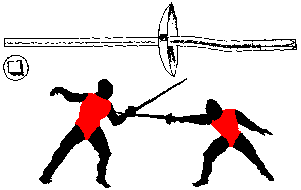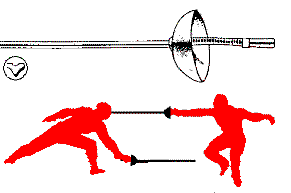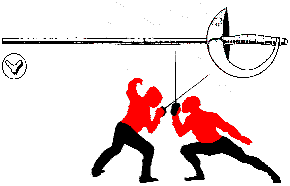Fencing is the art and science of Western swordsmanship, using one of three types of weapons, each with its own style and set of rules. Today it is taught mostly as a sport. Meets are conducted as individual or team events, although as a team fencers still compete one-on-one. The sport develops agility, speed, strength, and cunning. Both men and women compete in fencing.
The Weapons: Three Kinds of Swords
Foil

The foil has a slender, quadrilateral blade (35 inches long) with a small, circular guard. Foil fencers must follow a certain sequence of movements called conventions to establish right-of-way, which determines who can score.
The target area in foil is anywhere on the torso and points are scored using only the tip.
Epee

The epee has a rigid triangular blade (35 inches long) with a bell-shaped guard.
The target area in epee is the entire body, but touches must be scored with the tip of the weapon. If both fencers hit each other at the same time, both touches score.
Sabre

The sabre has a flexible triangular blade (35 inches long) and a guard that curves around the knuckles.
The target area in sabre is any part of the body above the hips, including the head and arms. Touches may be scored using either the tip or the cutting edge.
Chess on Feet: How to Watch a Fencing Bout
What would you do if someone suddenly came at you with a sharp sword? Your first concern would be to defend yourself. If you avoided being hit, you would then try to hit your opponent. In fencing terms, this combination of actions establishes right-of-way. Stated simply, an attacker has the right to hit and score a point until the defender blocks (or parries) the attack. If the defender responds immediately by returning an offensive cut or thrust (a riposte) he gains the right to hit and score.
Fencers must try to maintain a safe distance from each other. They want to stay out of range of the opponent's attack while staying in position to make an attack. They must therefore "break" the distance. Fencers often make "fake" attacks or feints to gauge an opponent's reactions and change the distance, timing, and rhythm of the bout while setting up for a real attack.
Fencing is difficult to follow at first because of the lightning speed of the actions and the sometimes complex exchanges. To become more comfortable watching a bout, focus on one fencer. If that one is attacked, to score he must first parry and then riposte. If a there's a touch, the action is stopped and it's determined if a point is to be awarded.
Did You Know . . .
- The tradition of fencers wearing white uniforms goes back to the days before electric scoring was used in competition. Back then, hits were determined by ink spots left by the weapon. Cheaters still found a way to beat this, though. By dipping their uniforms in vinegar (which was used to clean off the ink marks indicating the touches), no mark would be left when a hit was made!
- Fencers saluting with their masks off is a tradition from duelling. When contestants met, they had to show their faces to prove their identities—otherwise, it would be easy to have someone else fight in your place.
- The original strip, or piste, was marked out on the ground to designate boundaries for a duel. If one of the duelists stepped outside the line, he was labelled a coward. So, the strip symbolizes honor and courage in the match.
- Fencing became an Olympic event in 1896; It is one of only six sports to be featured in every modern Olympic Games.


